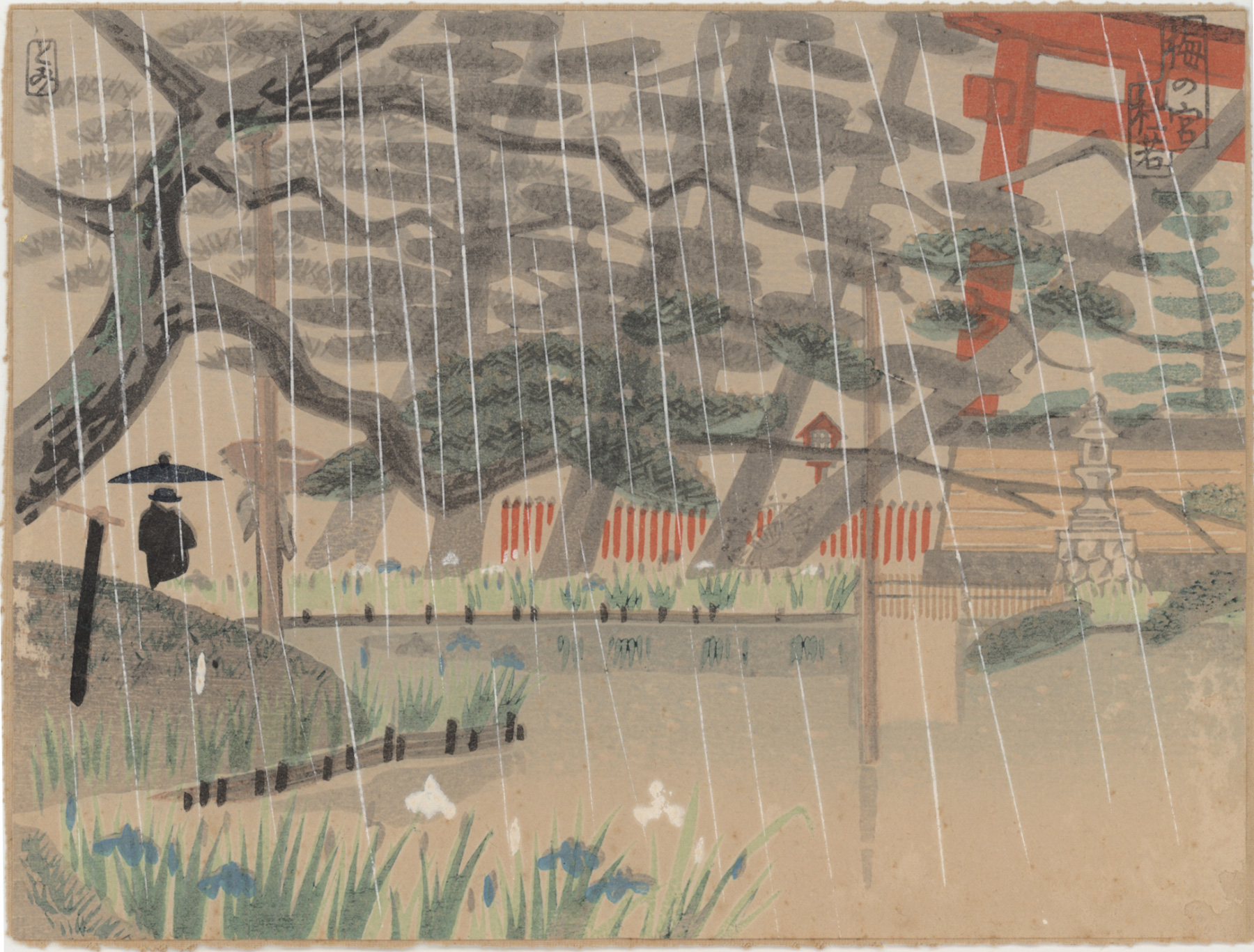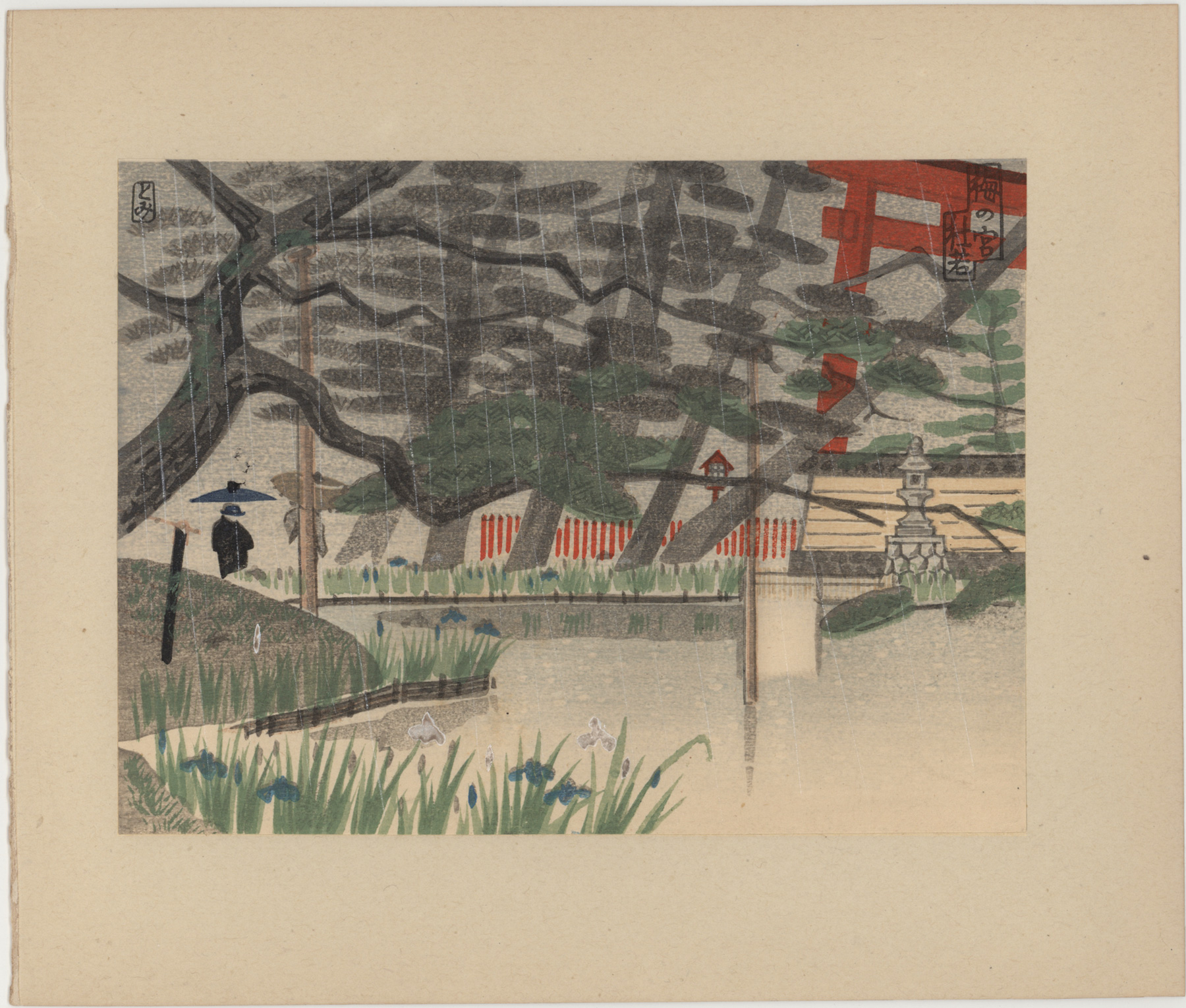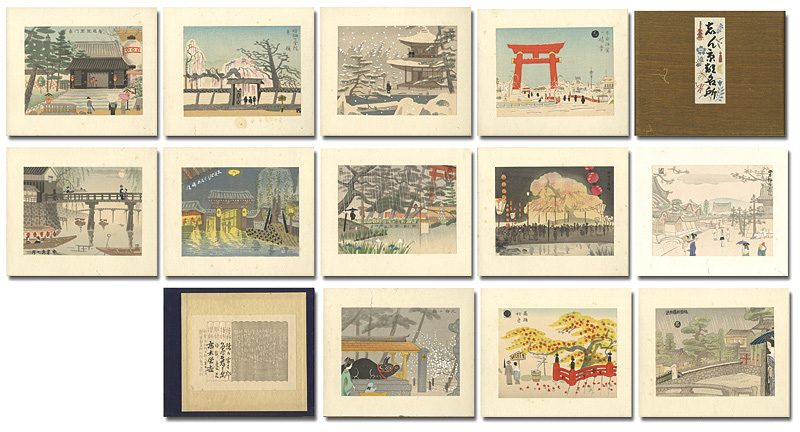 | Japanese Color Woodblock PrintUmenomiya Shrinefrom the series New Famous Places of Kyotoby Kamei Tōbei, after 1953 |
IHL Cat. #1125
(print is mounted on portfolio heavy backing paper which is trimmed almost to the image)
IHL Cat. #2191
(print is trimmed to image and mounted on portfolio heavy backing paper)
About This Print
One of twelve small-size prints (approx. 5 x 6.5 in.) from the portfolio titled New Famous Places of Kyoto (志ん京都名所 Shin Kyōto meisho), designed by the artists Kamei Tōbei (1901-1977) and Tokuriki Tomikichirō (1902-2000)*, and published by the New Famous Places of Kyoto Publication Society (新京都名所刊行会).
The two artists often collaborated and the publishing entity New Famous Places of Kyoto Publication Society, is likely a construct of the two artists.
* It is unclear if Tokuriki actually designed any of the prints themselves as all the prints carry some version of Kamei's artist seal.
This print depicts a solitary visitor walking through the gardens of Umenomiya Shrine on a rainy day.
* It is unclear if Tokuriki actually designed any of the prints themselves as all the prints carry some version of Kamei's artist seal.
The Complete Portfolio
Six or more of the print designs in this portfolio seem to have also been issued at another time, possibly printed using different blocks. The website of The Agency of Cultural Affairs - Cultural Heritage Online contains six of these prints, with each print visibly different from the prints in this collection. As with this collection's prints, their prints are not dated, but they attribute the prints to Kamei Genbei, a name used by Kamei after 1953, which helps narrow the publication dates to post-1953.
Umenomiya Shrine
Source:Wikipedia http://en.wikipedia.org/wiki/Umenomiya_Shrine and as footnoted
Umenomiya Shrine (梅宮大社) is a Shinto shrine located in Ukyō-ku in Kyoto, Japan. The shrine became the object of Imperial patronage during the early Heian period. In 965, Emperor Murakami ordered that Imperial messengers were sent to report important events to the guardian kami of Japan. These heihaku were initially presented to 16 shrines; and in 991, Emperor Ichijō added three more shrines to Murakami's list. Three years later in 994, Ichijō refined the scope of that composite list by adding Umenomiya Shrine (梅宮神社 Umenomiya-jinja) and Gion Shrine, which is now known as Yasaka Jinja.
From 1871 through 1946, the Umenomiya Shrine was officially designated one of the Kanpei-chūsha (官幣中社), meaning that it stood in the second rank of government supported shrines.
At first sight, this shrine seems small, but it has a large garden.1
1 Website of The Kyoto Project http://thekyotoproject.org/english/umenomiya-shrine/
Print Details
| IHL Catalog | #1125 and #2191 |
| Title | Umenomiya Shrine 梅の宮社若 |
| Series | New Famous Places of Kyoto 志ん京都名所 |
| Artist | Kamei Tōbei (1901-1977) |
| Signature | not signed |
| Seal |  |
| Date | after 1953 |
| Edition | unknown |
| Publisher | 新京都名所刊行会 New Famous Places of Kyoto Publication Society |
| Impression | IHL Cat. #1125 and #2191 : excellent |
| Colors | IHL Cat. #1125: good - minor fading; IHL Cat. #2191:excellent |
| Condition | IHL Cat. #1125: fair - backed with stiff paper trimmed to image (the original portfolio mounting trimmed); paper loss lower right corner IHL Cat. #2191: good - vertical ripples |
| Genre | sosaku hanga (creative print) |
| Miscellaneous | |
| Format | yotsugiri |
| H x W Paper | IHL Cat. #1125: 4 13/16 x 6 7/16 in. (12.22 x 16.35 cm) IHL #2191: 4 3/4 x 6 3/8 in. (12.1 x 16.2 cm) IHL #2191 backing paper: 7 1/16 x 8 1/4 in. (17.9 x 21 cm) |
| Collections This Print | |
| Reference Literature |
last updated:
10/13/2019



